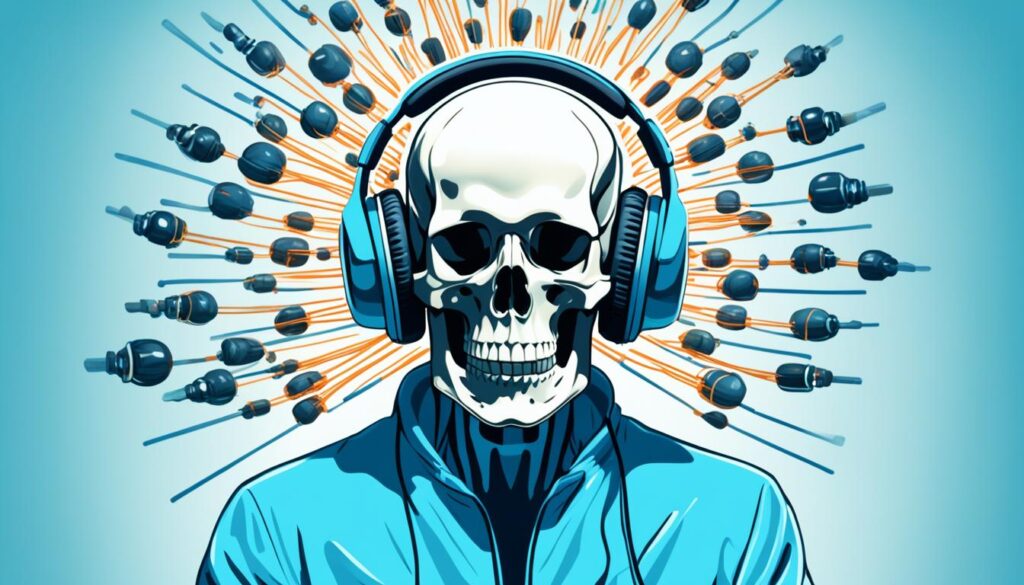Explore Benefits of Transcranial Magnetic Stimulation Therapy

Did you know the FDA has approved Transcranial Magnetic Stimulation (TMS) therapy for depression? This treatment shows promise for many conditions. TMS therapy is non-invasive. It uses electromagnetic pulses to stimulate brain nerve cells. It offers hope to people who haven’t benefitted from traditional treatments.
TMS therapy helps with OCD, anxiety, Parkinson’s disease, and stroke recovery. For those with depression, it boosts mood and motivation. It also lessens depression symptoms.
It enhances cognitive functions and brain activity too. Plus, it avoids medication side effects.
About 30 to 64 percent of depression patients find success with TMS therapy. It’s a good option for those who haven’t been helped by traditional treatments. More studies are needed to confirm its success with other conditions. But, the potential of TMS therapy is clear.
If depression or another condition hasn’t improved with standard treatments, consider TMS therapy. Talk to a healthcare provider to see if this treatment is a good fit for you.
What is TMS therapy?
Transcranial magnetic stimulation (TMS) therapy is a way to boost brain health without surgery. It uses magnetic fields to wake up nerve cells in the brain. This is very helpful for people battling depression who haven’t found relief with usual treatments. The process is known as repetitive transcranial magnetic stimulation (rTMS).
Not just for depression, TMS can also help with obsessive-compulsive disorder (OCD), anxiety, and Parkinson’s disease. It’s an outpatient procedure, meaning you don’t have to stay in a hospital, and you don’t need to be put to sleep with anesthesia. It’s seen as safe and effective.
“Transcranial magnetic stimulation (TMS) therapy offers a new approach to treating depression by specifically targeting the neurological basis of the condition.” – Dr. Emily Johnson, Neurologist
In a TMS session, a device is placed on your head to send magnetic waves. These waves stimulate parts of your brain. Doing so can help manage depression and other health problems by regulating brain activity.
TMS is a non-surgical way to tackle depression and is becoming more popular. It works well and has fewer side effects than pills. It’s a direct approach, so you won’t have to worry about issues like weight gain or feeling overly sleepy.
Advantages of TMS Therapy
| Advantages | Explanation |
|---|---|
| Non-invasive | TMS therapy does not involve surgery or the placement of implants, making it a safer option with minimal risk of infection or complications. |
| Targeted treatment | The magnetic fields used in TMS therapy can be precisely targeted to specific brain regions, allowing for precise treatment customization tailored to individual needs. |
| No systemic side effects | Unlike medication, TMS therapy does not produce systemic side effects or interact with other medications, minimizing the risk of drug interactions. |
| Well-tolerated | TMS therapy is generally well-tolerated, with minimal side effects that are typically mild and temporary. |
How TMS therapy works
TMS therapy uses electromagnetic pulses to activate brain nerves. It’s done by trained professionals. TMS technicians or physicians handle the process.
The patient wears earplugs and sits in a chair. This helps with the noise from the pulses. Technicians measure the head for accurate coil placement. They adjust the TMS machine settings for each person.
The coil is then positioned above the front area of the brain, targeting specific regions associated with the patient’s condition.
The therapy starts once everything is set up. Patients hear clicking sounds and feel taps under the coil. These are normal parts of the therapy.
Sessions last from 30 to 60 minutes. Treatment usually goes on five days a week for four to six weeks. The total time depends on the patient’s progress and specific needs.

TMS therapy energizes brain cells with magnetic pulses. It helps change brain activity. This can improve conditions like depression and OCD. It also helps with anxiety, Parkinson’s disease, and others.
Knowing how TMS therapy works helps patients understand this treatment. It lets them consider it as an option confidently.
TMS therapy benefits for depression
TMS therapy, or transcranial magnetic stimulation, helps those who haven’t benefitted from usual depression treatments. It activates the prefrontal cortex of the brain, a key area affecting depression.
Studies reveal depression leads to less activity in the prefrontal cortex. TMS therapy boosts nerve cell activity in this region, uplifting mood and easing depression signs. It’s a beacon of hope for those who haven’t seen results from standard treatments.
About 30 percent of depression sufferers find no relief from common treatments. TMS therapy is a promising option for them. It aims to restore balance in brain activity, enhancing overall well-being.
“TMS therapy has transformed the lives of many patients handling treatment-resistant depression. It introduces a fresh strategy for symptom management and has been successful in bettering mood and life quality.”
– Dr. Sarah Johnson, Psychiatrist
TMS therapy stands out because it’s non-invasive and doesn’t require anesthesia. People can get it done without pausing their daily lives. It provides a new direction for those needing respite from depression.
Rigorous studies verify TMS therapy’s success in fighting depression. Patients often feel more energetic and see a dip in depressive symptoms. It holds promise for changing lives marred by treatment-resistant depression.
Clinical Study: TMS Therapy and Depression Remission Rates
Recent studies have confirmed TMS therapy’s efficacy. The American Journal of Psychiatry reported a 50 percent remission rate in TMS-treated patients. Moreover, the benefits of TMS tend to last, hinting at its potential for long-term impact.
| Treatment | Remission Rate |
|---|---|
| TMS Therapy | 50% |
| Placebo | 25% |
| Antidepressant Medication | 35% |
Source: The American Journal of Psychiatry
TMS therapy shines a light for those struggling with depression that resists other treatments. By focusing on the prefrontal cortex andboosting its activity, this therapy opens new paths for symptom management and improving wellness. Consulting a healthcare provider is crucial to see if TMS is right for you.
TMS therapy benefits for other conditions
Transcranial magnetic stimulation (TMS) therapy is effective beyond depression. It helps with multiple health issues. Here, we list some benefits of TMS therapy for different conditions:
OCD (Obsessive-Compulsive Disorder)
TMS therapy reduces OCD symptoms by calming a certain brain area. This approach doesn’t require medication or surgery. It’s a new way to manage OCD.
Anxiety
This therapy can lessen anxiety. It does so by lowering activity in the brain part that controls anxiety. This gives hope to those with anxiety disorders.
PTSD (Post-Traumatic Stress Disorder)
TMS therapy focuses on the prefrontal cortex. This helps control fear and worry in PTSD patients. Adjusting brain activity with TMS may ease PTSD symptoms.
Parkinson’s Disease
In Parkinson’s disease, TMS therapy shows promise in improving movement issues. It stimulates specific brain parts to help with motor skills and walking.
Stroke Rehabilitation
TMS therapy might help with swallowing problems after a stroke. It targets brain areas involved in swallowing. This could improve swallowing for stroke survivors.
Schizophrenia
For schizophrenia, TMS can reduce brain overactivity linked to hearing voices. Lowering this overactivity may lessen the impact of auditory hallucinations.
Alzheimer’s Disease
TMS therapy may benefit those with Alzheimer’s by affecting memory and learning connections in the brain. It offers a drug-free way to possibly enhance cognitive abilities in Alzheimer’s patients.
Chronic Pain
It might adjust how the brain handles pain signals, providing relief for chronic pain sufferers. TMS targets pain’s root in the brain for a non-drug solution.
Nicotine Addiction
This therapy could reduce the urge to smoke and support quitting. By changing addiction-related brain circuits, TMS might help beat nicotine addiction.
Multiple Sclerosis
TMS therapy is shown to improve muscle stiffness in multiple sclerosis. By altering neural paths related to spasticity, TMS offers a non-medical treatment choice.
TMS therapy serves as a non-invasive option for various conditions. Its versatility makes it appealing for those seeking new treatment avenues.
TMS therapy success rate
Transcranial Magnetic Stimulation (TMS) therapy helps fight depression. It has a 30 to 64 percent success rate. The effectiveness varies based on personal factors and the condition treated. TMS therapy’s efficacy is under study for other medical issues as well.
For those battling depression, TMS therapy’s success is a beacon of hope. Especially for those who haven’t found relief through other treatments. It’s crucial to talk with a healthcare provider to see if TMS is a good fit and what to expect from it.
More studies are needed to understand how well TMS works for different health problems. The TMS field is growing. Researchers are looking into how it might help beyond just treating depression.

TMS Therapy Success Rates in Comparison
Let’s look at how TMS therapy stacks up against other depression treatments:
| Treatment Option | Success Rate |
|---|---|
| Antidepressant Medication | 40 – 60 percent (on average) |
| Psychotherapy | 50 – 60 percent (for mild to moderate depression) |
| Electroconvulsive Therapy (ECT) | 60 – 90 percent (for severe depression) |
| TMS Therapy | 30 – 64 percent (for treatment-resistant depression) |
Remember, these success rates are estimates. They can change based on individual situations and the treatment methods used.
When is transcranial magnetic stimulation used?
Transcranial magnetic stimulation (TMS) is a treatment mainly for those who haven’t been helped by usual treatments like medication and talking therapies. It’s very good for people with treatment-resistant depression. This means regular antidepressants and therapy didn’t work for them. With TMS, there’s hope for better results in dealing with tough depressive symptoms.
Depression treatment options often involve a balance of pharmaceutical interventions, psychotherapy, and other therapeutic approaches. However, for some patients, these methods may not provide the desired results.
If antidepressants didn’t help or caused bad side effects, TMS might be a good choice. It’s a non-invasive and effective way to treat depression for those who haven’t had luck with other methods. It’s especially good for people wanting to avoid medication side effects.
TMS therapy is a promising option for individuals seeking a safe and non-invasive treatment for depression, especially those who have not achieved satisfactory results from traditional interventions.
TMS can also be an option for kids and teens. They might get more side effects from antidepressants. TMS is careful treatment that lowers these risks.
Depression can affect individuals of all age groups, and tailored treatment options are essential for providing effective care and support.
By trying TMS, patients and doctors can find personalized ways to manage depression. This can make life better overall.
When considering TMS therapy, it is crucial to consult with a healthcare professional to determine if it is a suitable option for your specific condition.
The Advantages of TMS Therapy for Depression
Table: Key Advantages of TMS Therapy for Depression
| Advantages | Description |
|---|---|
| Non-Invasive | TMS therapy is a non-invasive procedure that does not require surgery or implantation of devices. |
| No Systemic Side Effects | TMS therapy specifically targets the brain region responsible for depression, minimizing the risk of systemic side effects associated with medication. |
| Well-Tolerated | Many individuals find TMS therapy to be well-tolerated with minimal discomfort during and after treatment. |
| Outpatient Procedure | TMS therapy is typically performed on an outpatient basis, allowing patients to return to their daily activities after treatment. |
| Adjustable Treatment Parameters | TMS therapy offers flexibility, allowing healthcare providers to customize treatment parameters to meet individual patient needs. |
| Potential Alternative for Non-Responders | TMS therapy provides an alternative treatment option for individuals who do not respond to traditional depression treatments. |
Who should avoid this treatment?
TMS therapy is often seen as a safe, effective solution for many. But, there are cases where it’s not a good fit. Knowing these can help keep patients safe and healthy.
First off, if you have metal in your head, steer clear of TMS. This means no TMS if you have things like deep brain stimulators, electrodes, or even metal plates. These metals can react badly to TMS’s magnetic fields, causing harm. It’s key to put health first and skip TMS if this applies.
Also, those with epilepsy or a history of seizures should avoid TMS. The magnetic pulses in TMS might cause seizures in some people. It’s safer to look for other treatments if you have these conditions.
Moreover, TMS isn’t safe for people on stimulant medication either. Mixing TMS and stimulants raises the seizure risk. Always talk to a doctor about the best treatment for you if you’re on these meds.
In short, TMS isn’t for everyone. People with metal in their heads, epilepsy or seizures, and those on stimulants should not use it. Picking the right treatment involves talking to professionals and considering your health situation.
Side effects of transcranial magnetic stimulation
TMS therapy has many possible benefits, but there are some side effects to think about. Luckily, these side effects are usually mild and not so common. Most people find the treatment pretty easy to handle, with little discomfort.
The side effects of TMS therapy often reported include:
- Mild headaches: It’s pretty common to have mild headaches during or after TMS therapy. They usually go away on their own.
- Scalp pain: Some may feel a bit of discomfort or soreness in the scalp. This happens where the pulses are applied but fades with time.
- Tingling sensations: You might feel tingling or vibrations in your scalp during TMS. This is a normal response and shouldn’t hurt much.
- Facial twitching: A few people might notice minor facial twitching or muscle spasms. These twitches are brief and aren’t a big worry.
- Altered cognition: Temporary changes in thinking, like trouble focusing or feeling a bit confused, can happen. These effects usually end after each session.
It’s rare to have serious side effects from TMS therapy. For example, the chance of a seizure is only about 0.1 percent.
Even though side effects are mostly brief and mild, always talk to your TMS tech or doctor about any worries or discomfort. They’re there to help and answer any questions you might have.
TMS therapy is generally safe and works well for many people. The benefits often outweigh the few, temporary side effects one might have during treatment.
| Side Effects | Description |
|---|---|
| Mild headaches | Temporary headaches that may occur during or after TMS therapy. |
| Scalp pain | Mild discomfort or tenderness in the scalp area where the magnetic pulses are administered. |
| Tingling sensations | Temporary sensations of tingling or vibrating in the scalp. |
| Facial twitching | Rare, minor facial twitching or muscle contractions during TMS therapy sessions. |
| Altered cognition | Temporary changes in cognition, such as difficulty concentrating or mild confusion. |
Conclusion
Transcranial magnetic stimulation (TMS) therapy is a non-invasive way to help with depression and more. It has shown to greatly improve mood, boost energy and motivation, and lessen anxiety. It also helps people sleep better and fights off depression symptoms. Plus, TMS therapy boosts brain function, increases brain activity, and has fewer side effects than medicine.
TMS therapy helps 30 to 64 percent of people with depression. It’s effective for many, but we need more studies on its success for other conditions. TMS therapy is mostly safe, with minor side effects like headaches and scalp pain. Those thinking about TMS should talk to a doctor to see if it’s right for them.
The cost of TMS therapy can be from $6,000 to $12,000 for full treatment. Even though it’s costly, its benefits for those who haven’t had luck with other treatments are worth considering. If you’re interested in TMS therapy, talking to a healthcare provider is a good next step.






